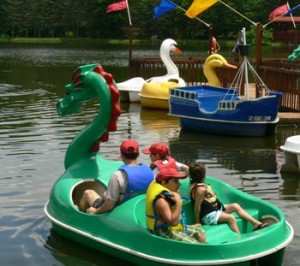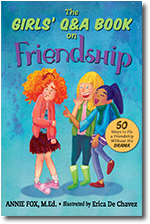|
|
July 12, 2013
 There's nothing to do! (and it's all your fault) It’s July. Likely the summer doldrums have already moved in. Maybe you’ve already been accosted by your kids’ complaining, “Mom, I’m bored!” in that grating tone they use to let you know you’re failing as a parent.
I didn’t hear “I’m bored” very often from either of my kids. They’re adults now, both professional writers and both comedy improv performers. No lack of creativity there. But my son, now 6’1″ was always a ravenous boy. From him I often heard “Mom, I’m hungry!” His assumption: it was my job to feed him even when was old enough to take or make his own snack. Solution: I taught him to cook. Which he still enjoys and is very good at.
When we don’t let kids experience lulls in “fun time,” when Mom or Dad automatically become The Entertainer, kids are less likely to teach themselves to push through boredom and make their own fun. If we teach kids that it’s our job to do for everything for them, why should they bother learning to be creative? Why should they even bother thinking about what they might enjoy doing?
Summer can feel especially long when every moment of every day is unstructured. But a long summer can be such a gift to the imagination and the spirit. Here are some tips for helping your kids learn to banish boredom and get inspired!
1. Lead by example. There are things you love to do that tap into your creativity and stimulate your imagination. When kids see us being creative and fully involved in a project, they get the message, “In this family we put our imagination to work. And look how much fun and satisfaction we get!”
2. Talk about process. Being creative is often about experimentation and process more than product. When you catch your child in the act of doing something creative let him or her know that you admire their choice of activity. (Don’t worry about the mess!) If they produce a “product,” a drawing, a song, a dance, a video, a dozen cookies, a bird house, a garden, a lemonade stand, or a philanthropic campaign, then ask your child about the experience. How did you do that? What inspired you? How’d you feel while you were in the middle of it? What’d you learn? What would you do differently next time? What are you planning next? etc. These conversations inspire kids to continue being creative.
3. Unplug. With so much unstructured time, plugging in to a game, an app, or Social Media is an easy fix for “I’m bored!” But it’s also a time-sink and it’s not likely to teach your kids anything about their true passions, interests, and creative strengths. Family vacations are a great time to unplug. Sure it’s easier if you’re off the grid, but guess what? Even if you’ve got access, every digital device has a POWER-OFF switch. (Who knew?) Model self-discipline with your own devices. Show your kids what an imaginative adult looks like. Use family vacations to be with the family and play together in new creative ways.
It’s summer. Have fun as a family and show your kids how to do it on their own.

July 9, 2013
 Let's ride across the lake on a dragon! Right before the light turned green I glanced out my window and saw a four-year-old swinging in front of her house. Lucky girl with parents cool enough to tie that swing on the tree. Smiling, I remembered the endless freedom of summer days with no particular place to go. Then the light turned and off I went, back into adulthood.
Summer is a portal to the land of “Who Knows Where Until You’re There.” It’s also a golden pass from the scheduling gods. (Or it should be.) Because, let’s face it, time away from routine provides the breather we all need to step back, relax, try something different, have fun, and then return to “normal life” with renewed interest and energy.
As a kid in summer, I planned my own days, each one radiating endless possibilities. In September, my new level of self-reliance stayed with me, propelling me into a new school year. Summer holds that potential for every kid, provided (s)he has the freedom and time. But that doesn’t mean vacationing kids should veg out for days in front of one screen or another. That’s as unhealthy as corralling them into daily math & reading drills. Please don’t do either. But please do encourage fun and learning.
Let’s define terms. Learning is anything that exposes kids to new ideas, stretches the mind, promotes new ways of thinking, builds skills and knowledge, and/or encourages creativity. Summer can be a wonderful time for all sorts of special learning experiences. And because most parents are also “on break” during parts of the summer, families can learn together. Here are a few tips to make fun and learning part of this summer:
1. Call a family meeting. Discuss special projects and activities the family can take on during the summer. Let kids take the lead but you should also bring some ideas to the table by first checking the Events section of your local newspaper, your town website, or search for “Summer Activities for Kids and Families (your city name).” Educational/cultural institutions have plenty of program offerings. Find out what’s available, talk it up to your kids, and take part.
2. Be creative. Don’t let the close of school close the mind. Since many schools have cut out creative arts, summer is a great time to bring back those opportunities. Make arts and crafts. Make music and home videos. Make food and share the delicious goodies with your neighbors. When you do that, you’re also teaching generosity.
3. Have an adventure. Gorgeous weather is a terrible thing to waste. Seize the day and tap into a child’s natural desire for adventure. Unfortunately, many kids only satisfy this by playing computer games. But real trails, parks, streams, and shorelines are out there waiting for young adventurers. Google “Hiking (your city name)” and discover nearby natural environments for your family to explore. Print out maps before you go and let the kids help navigate.
4. Visit your public library. (We remember books, don’t we?) Ask a librarian for recommendations or better yet, have your children talk to the librarian about the kind of books they enjoy. Gather the family together each evening for a story or chapter or two. (Here are some free classic fairytales to get you and the kids in the mood.) Whatever you’re reading, talk about the use of language, characters, and plot points. Rather tell stories than read them? Here are some storytelling tips from a master.
5. Watch classic films. Summer themed or otherwise, a great film is a treasure trove of educational possibilities. Share some of your favorite films from childhood and let your kids choose their favorites. Discover new ones, including kid-friendly foreign films. Make popcorn! Snuggle! Critique the films! It’s all learning, as in learning what it feels like to be part of a loving family. (How else will your children be able to re-create this sense of “us-together” for their own kids some day?)
Twenty-first century childhoods are different from the ones we had. Yet, summer still has the power to inspire dreaming. During the school year, our kids carry a lot on their shoulders and in their psyches. They need down time. You do too. When we use summer to play with our kids and engage in creative, thoughtful activities, we strengthen family bonds and instill in children the love of learning. If not now, when? Try taking it a little easier this summer and encourage your kids to do the same. When we slow down, and have no particular place to go, we meet new parts of ourselves.
Have a happy healthy and safe summer from my family to yours.

June 27, 2013
 Guiding each other toward independence by Megan Sullivan
Continuing July’s Independence theme, I’m pleased to post this guest blog by Megan Sullivan. Megan is a free-lance writer. She lives in Southern California with her husband and their two daughters.
My daughter is already fifteen, stands two inches taller than me and has a driver’s permit, so you would think that I would be prepared for anything. We made it through the training bra, the menstrual cycle and now we have moved onto “real bras.” I get embarrassed when boys look at her, but I really was coping with her maturing physique.
Then it happened… my little girl came to me, hair in a sweet braid, looking extra innocent with a piece of paper in her outstretched hand. I was thinking she must have achieved something in school or had a letter for me to sign. But when I looked closely at the paper I felt faint. She had printed out a Victoria Secret coupon (I’ve raised money-conscious kids!) and she wanted me to take her shopping for more grown-up undergarments.
Her smile said that she expected me to high five her choice in lingerie, drive to the mall to pick-up some lacy underthings, and send her out into the wide world with her thong straps showing above her waistline. Instead, she got Mom making sounds kept without forming sentences. My daughter has yet to start dating, but my mind leapt quickly from underwear to teen pregnancy, to appearing on one of those terrible daytime talk shows where everyone yells.
All I could utter was a stilted, “Why?”
Apparently, her friends shop at VS all the time and lately they had been poking fun at her off brand undies as she changed in the locker room. Nothing more to it than typical mean girl antics. I don’t remember kids being brand conscious down to the skivvies, but I can understand the desire to feel good about yourself and the need to fit in with your gal pals. I guess my generation did see the rise of Calvins.
Beyond impressing her besties, my daughter is growing into a woman and cares about her appearance from top to bottom. She laughed when I said, “Do we need to talk about boys again?” She promised that at this time these items were for herself, and reminded me that Victoria’s Secret carries plenty of ‘normal underwear’, not just sheer leopard print push-up bras.
“I’ll talk to you before a boy sees my underwear, Mom.” she promised, like a young woman present and in control of her choices.
So we went shopping together and my girl steered clear of the store’s naughtier items, barely even giving them a glance. She’s also taught me that there’s more to cute underwear than just sex appeal, so I picked up a few cute items of my own.
As our kids grow-up, sometimes they turn out to be more mature than we are. It’s a great feeling to be able to talk to your child like an adult, even if sometimes you still see her as a five-year-old. It’s a part of the path that was made for each of us. I admire my daughter’s smarts, sensitivity, and her sense of style. We won’t always see eye to eye, but I am learning to cope with this new chapter of parenting and enjoy our differences as she becomes a close friend.

June 17, 2013
 End of one chapter, start of the next I’m wired to cry. So naturally I sobbed hysterically after dropping my 18-month-old daughter at preschool. (Hey, I got better by the second week!) And I bawled as I dropped her off at college. And when her little brother left for college six years later, the waterworks gushed again. Kids beginning a new chapter in life can do that to parents. It can also make us feel incredibly proud, especially if they (and we) worked hard to reach that point.
As graduation parties wind down and you begin thinking about the next round of challenges coming up in the fall, here are some tips to help you through this transition:
- Let them have their summer: Kids need to relax and so do we. Yes things must get done before the new term, but unless your child won’t calm down until all school supplies and clothes are purchased, then save it for August and let them enjoy a balance of structured and unstructured time.
- Step back so they can step up: From September to May kids use the “I’ve got homework” excuse to avoid lending a hand around the house. Tell them that pass has expired. Besides, summer is a great time to help kids to develop responsibility. They’ll need it because each new grade level requires kids to take more responsibility for their education. They’ll only meet upcoming challenges when we require more of them as members of Team Family. Be specific with your summer expectations and hold the kids accountable. NOTE: Do not load them down with home and garden projects all day every day. Remember, it’s summer! (See tip #1)
- Create new goals for yourself: Our kids are moving toward independence – just as Nature intended. We’re moving in that direction too and eventually we’ll work our way out of this full-time parenting gig. That’s part of your job description. (Check the fine print on your kid’s birth certificate.) Even if your child is just starting first grade in the fall, the clock is running down on the “under the same roof” phase of parenting. Summer is a great time to remember that before you were a parent you were a person with unique interests and talents. What would you do with at least one extra hour a week just for yourself? Set a goal for yourself this summer and get started. Let your kids in on the goal and on your progress, too. (That’s great modeling!) If you chose well, working on your goal will sustain you on many levels when your child (eventually) leaves the nest.
Now go have some summer fun and pass me a tissue on the way out.
 — Older Posts »
| |















